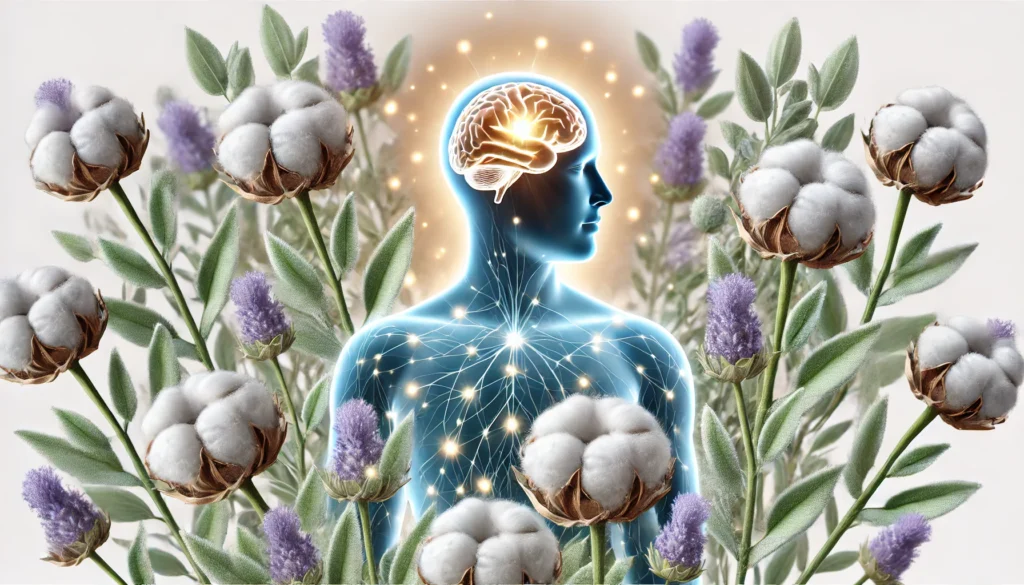Lavender cotton (Santolina chamaecyparissus), a small, aromatic shrub native to the Mediterranean region, has been traditionally used for its medicinal properties, particularly in herbal remedies for digestive issues, skin conditions, and mild sedative effects. More recently, it has gained attention for its potential nootropic properties, prompting interest in its effects on cognitive function, memory, and neuroprotection. This article provides a comprehensive examination of lavender cotton, detailing its chemical composition, physiological mechanisms of action, potential nootropic benefits, dosing considerations, possible side effects, drug interactions, and precautions for safe supplementation.
You May Also Like:
Ginkgo Biloba: Benefits, Dosage, Side Effects, Drug Interactions, And Other Important Information
Sources of Lavender Cotton
Lavender cotton, often mistaken for true lavender due to its similar scent, belongs to the Asteraceae family rather than the Lamiaceae family of traditional lavenders. The plant thrives in dry, rocky soils and is commonly found in Southern Europe, North Africa, and parts of Asia. Historically, its leaves and flowers have been used in traditional medicine for their antimicrobial, anti-inflammatory, and calming properties.
The primary active components of lavender cotton are sesquiterpenes, monoterpenes, flavonoids, and phenolic acids, which contribute to its biological effects. The essential oil extracted from the plant contains a complex mixture of bioactive compounds, including camphor, borneol, thujone, santolina alcohol, and various polyphenols.
Chemistry of Lavender Cotton
The chemical composition of lavender cotton is responsible for its potential cognitive and neuroprotective effects. Some of the most relevant bioactive compounds include:
- Terpenoids – These include camphor, borneol, and thujone, which have been studied for their effects on the nervous system. Camphor and borneol have mild stimulant effects, whereas thujone has been noted for its interaction with GABA receptors.
- Flavonoids and Phenolic Compounds – These compounds exhibit antioxidant and anti-inflammatory properties, potentially protecting neurons from oxidative stress and inflammation.
- Santolina Alcohol – This lesser-known compound has been investigated for its antimicrobial and sedative properties, which may contribute to cognitive relaxation and stress reduction.
The essential oil of lavender cotton is particularly rich in terpenes, which have been found to cross the blood-brain barrier and exert direct effects on neuronal function, neurotransmitter modulation, and synaptic plasticity.

Physiological Mechanisms of Lavender Cotton in the Body and Brain
The mechanisms through which lavender cotton exerts its effects on cognitive function are complex and involve multiple physiological pathways. Key actions include:
- Modulation of GABAergic Activity
Certain compounds in lavender cotton, such as thujone and borneol, interact with the gamma-aminobutyric acid (GABA) receptors in the brain. While thujone has been linked to GABA receptor antagonism, leading to mild stimulant effects, borneol has shown GABAergic modulation that promotes relaxation and cognitive clarity. - Antioxidant and Neuroprotective Effects
Flavonoids and polyphenols in lavender cotton act as free radical scavengers, reducing oxidative damage in the brain. Oxidative stress is a key factor in neurodegenerative diseases such as Alzheimer’s and Parkinson’s, and reducing this stress may enhance cognitive longevity. - Anti-Inflammatory Properties
Chronic neuroinflammation is associated with cognitive decline. Lavender cotton’s bioactive compounds may inhibit pro-inflammatory cytokines, reducing neuroinflammation and promoting overall brain health. - Acetylcholine Modulation
Preliminary research suggests that some terpenes in lavender cotton may influence acetylcholine levels, a neurotransmitter essential for learning, memory, and focus. Enhancing cholinergic activity could make lavender cotton beneficial for cognitive enhancement.
Nootropic Benefits of Lavender Cotton
While clinical research on lavender cotton as a nootropic is still in its early stages, its phytochemical composition suggests several potential cognitive benefits:
- Cognitive Enhancement – By modulating neurotransmitters and reducing oxidative stress, lavender cotton may support memory, attention, and learning.
- Neuroprotection Against Oxidative Stress – The antioxidant properties of its flavonoids may protect neurons from age-related degeneration.
- Stress Reduction and Mental Clarity – GABAergic modulation through compounds like borneol may promote relaxation without significant sedation, leading to enhanced mental clarity.
- Potential Mood Regulation – By interacting with neuroinflammatory pathways and GABA receptors, lavender cotton may offer benefits for mood stability and anxiety reduction.
While these effects are promising, more rigorous human studies are needed to confirm its efficacy and safety as a cognitive enhancer.

Dosage and Supplementation Guidelines
Given the limited research on lavender cotton as a nootropic, dosage recommendations are largely based on traditional herbal use and extrapolations from its active compounds.
- Essential Oil Use – If using the essential oil for inhalation or aromatherapy, a few drops in a diffuser or diluted in a carrier oil may suffice.
- Capsule or Powder Form – Standardized extracts, if available, should be used with caution, typically within the range of 50-250 mg per day, depending on individual tolerance.
- Tea or Infusion – A mild infusion of dried lavender cotton leaves (1-2 grams per cup of hot water) may provide cognitive benefits without excessive exposure to active compounds.
Because certain constituents, like thujone, can be neuroactive in high doses, long-term or high-dose use should be approached with caution.
Side Effects and Safety
Lavender cotton is generally regarded as safe when used in moderate amounts, but potential side effects should be considered:
- Mild Gastrointestinal Upset – Some individuals may experience nausea or digestive discomfort when consuming lavender cotton.
- Neurological Effects – Excessive thujone intake has been associated with overstimulation, restlessness, or mild hallucinations in extreme cases.
- Allergic Reactions – As a member of the Asteraceae family, lavender cotton may trigger allergic responses in sensitive individuals.
Due to its potential neurological effects, those with epilepsy or seizure disorders should avoid high doses of lavender cotton.
Interactions with Other Supplements and Medications
Lavender cotton may interact with certain medications and supplements, particularly those affecting the nervous system. Key interactions include:
- Sedatives and Anxiolytics
- Lavender cotton’s GABAergic modulation may enhance the effects of sedatives like benzodiazepines (e.g., diazepam) or barbiturates.
- Nootropic Stimulants
- When combined with cholinergic or stimulant nootropics (e.g., caffeine, racetams, or modafinil), lavender cotton may either enhance or counteract their effects.
- Anticonvulsants
- Due to thujone’s potential to interact with GABA receptors, those taking anticonvulsants should consult a healthcare professional before use.
- Anti-Inflammatory Drugs
- The flavonoids in lavender cotton may have synergistic effects with NSAIDs or other anti-inflammatory agents, potentially enhancing their effects.
Risks for Individuals with Certain Health Conditions
Certain populations should use lavender cotton with caution or avoid it altogether:
- Individuals with Epilepsy or Seizure Disorders – Due to thujone’s neuroactive properties, it may increase seizure susceptibility.
- Pregnant and Nursing Women – The safety of lavender cotton in pregnancy and lactation has not been established, making its use inadvisable.
- People with Liver or Kidney Conditions – The metabolism of its terpenes and flavonoids may place additional strain on compromised liver or kidney function.
Conclusion: Should You Consider Lavender Cotton as a Nootropic?
Lavender cotton presents an intriguing but under-researched option as a nootropic supplement. Its potential cognitive benefits, including neuroprotection, mild cognitive enhancement, and stress reduction, stem from its complex mixture of bioactive compounds. However, its neuroactive components, particularly thujone, necessitate caution in dosing and long-term use.
For those considering lavender cotton as a nootropic, it is crucial to:
- Use moderate doses and monitor for side effects.
- Consult with a healthcare provider, especially if taking other medications.
- Prefer standardized extracts with verified safety profiles.
While lavender cotton shows promise as a supplement for cognitive and mood support, further scientific studies are needed to fully understand its efficacy and safety. Until more research is available, other well-studied nootropics may offer more reliable cognitive benefits.

References:
- Lavender Cotton – Uses, Side Effects, and More. Retrieved from: https://www.webmd.com/vitamins/ai/ingredientmono-698/lavender-cotton
- Chemical composition, antibacterial and antifungal activities of flowerhead and root essential oils of Santolina chamaecyparissus L., growing wild in Tunisia. Retrieved from: https://pmc.ncbi.nlm.nih.gov/articles/PMC5415143/
- Oxidative Stress in Cognitive and Epigenetic Aging: A Retrospective Glance. Retrieved from: https://pmc.ncbi.nlm.nih.gov/articles/PMC7093495/
Important Note: The information contained in this article is for general informational purposes only, and should not be construed as health or medical advice, nor is it intended to diagnose, prevent, treat, or cure any disease or health condition. Before embarking on any diet, fitness regimen, or program of nutritional supplementation, it is advisable to consult your healthcare professional in order to determine its safety and probable efficacy in terms of your individual state of health.
Regarding Nutritional Supplements Or Other Non-Prescription Health Products: If any nutritional supplements or other non-prescription health products are mentioned in the foregoing article, any claims or statements made about them have not been evaluated by the U.S. Food and Drug Administration, and such nutritional supplements or other health products are not intended to diagnose, treat, cure, or prevent any disease.


